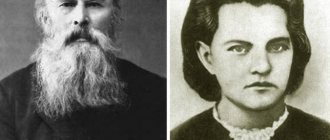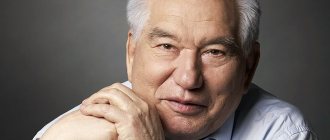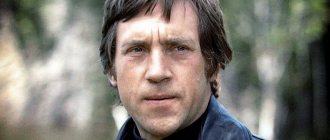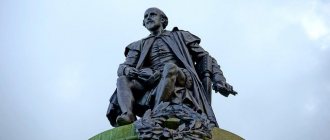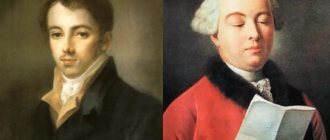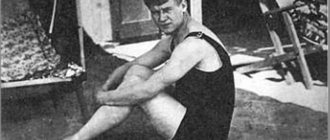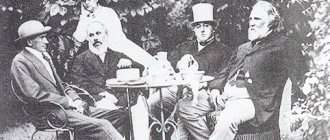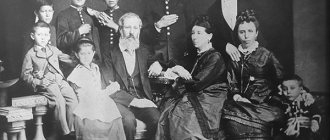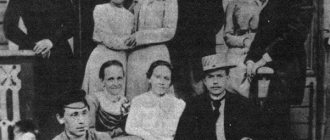Childhood and youth
The famous prose writer and human rights activist Vladimir Galaktionovich Korolenko was born on July 15 (old style), 1853 in the Ukrainian city of Zhitomir . Father, Galaktion Afanasyevich , worked as a district judge and had the rank of collegiate assessor. Mother, Evelina Iosifovna , took care of the house and family. The woman was Polish and communicated with the children in her native language, so little Volodya spoke Polish.
Vladimir Korolenko in childhood
In addition to Vladimir, the family raised five more children: the eldest son Julian , the youngest son Illarion and three younger daughters Maria , Evelina and Alexandra . Little Sasha lived for less than two years and died in 1967. A year later, the head of the family was buried next to her grave.
Volodya was accepted into the Polish boarding school of Rykhlinsky, then continued his studies at the Zhitomir gymnasium . Later the family moved to Rivne, where Galaktion Afanasyevich was transferred for service. The boy was placed in a real school in Rivne. In 1871, the young man went to St. Petersburg and successfully entered the Technological Institute.
During my student years
Vladimir Galaktionovich Korolenko Prepared by Madina Iskandarova, 5th “b” grade. - presentation
Vladimir Galaktionovich Korolenko Prepared by Iskandarova Madina 5 “b” grade
Vladimir Galaktionovich Korolenko, born July 15, 1853. Russian writer of Ukrainian-Polish origin, journalist, publicist, public figure, who earned recognition for his human rights activities both during the years of the tsarist regime and during the civil war and Soviet power. For his critical views, Korolenko was subjected to repression by the tsarist government. A significant part of the writer’s literary works are inspired by impressions of his childhood spent in Ukraine and his exile in Siberia. writerjournalistpublicist of the civil warUkraineSiberia writerjournalistpublicist of the civil warUkraineSiberia
childhood childhood Korolenko's childhood and adolescence passed in small towns where three nationalities collided: Polish, Ukrainian-Russian and Jewish. A turbulent and long historical life has left here a number of memories and traces full of romantic charm. All this, in connection with his semi-Polish origin and upbringing, left an indelible mark on Korolenko’s work and was clearly reflected in his artistic style, which made him similar to the new Polish writers - Sienkiewicz, Orzeszko, Prus. It harmoniously merged the best sides of both nationalities: Polish colorfulness and romance, and Ukrainian-Russian sincerity and poetry. Korolenko’s childhood and adolescence passed in small towns where three nationalities collided: Polish, Ukrainian-Russian and Jewish. A turbulent and long historical life has left here a number of memories and traces full of romantic charm. All this, in connection with his semi-Polish origin and upbringing, left an indelible mark on Korolenko’s work and was clearly reflected in his artistic style, which made him similar to the new Polish writers - Sienkiewicz, Orzeszko, Prus. It harmoniously merged the best sides of both nationalities: Polish colorfulness and romance, and Ukrainian-Russian sincerity and poetry.
His father is from an old Cossack family, his mother is the daughter of a Polish landowner in Volyn. His father, who served as a district judge in Zhitomir, Dubna, and Rivne, was distinguished by rare moral purity. His son described him in the main features in the semi-autobiographical story “In Bad Society”, in the image of an ideally honest “master judge”, and in more detail in “The History of My Contemporary”
In 1870, Korolenko completed a course at the Rivne real school. Not long before this, his ideally unselfish father died, leaving his large family almost without any means.
When Korolenko entered the St. Petersburg Institute of Technology in 1871, he had to endure the most severe hardship; he could afford to dine for 18 kopecks at a charity kitchen no more than once a month. In 1872, thanks to the efforts of his energetic mother, he managed to move to Moscow and become a scholarship student at the Petrovsko-Razumov Agricultural Academy. In 1874, for filing a collective petition on behalf of his comrades, he was expelled from the academy. Having settled in St. Petersburg, Korolenko and his brothers earned a living for themselves and their family by proofreading work. In 1872, thanks to the efforts of his energetic mother, he managed to move to Moscow and become a scholarship student at the Petrovsko-Razumov Agricultural Academy. In 1874, for filing a collective petition on behalf of his comrades, he was expelled from the academy. Having settled in St. Petersburg, Korolenko and his brothers earned a living for themselves and their family by proofreading work.
In Bad Society The story was almost entirely written during the years of Vladimir Korolenko’s exile in Yakutia. Later, the author worked on it in 1885 in St. Petersburg, in a pre-trial detention center, where he had to sit for several days. The story was almost entirely written during the years of Vladimir Korolenko’s exile in Yakutia. Later, the author worked on it in 1885 in St. Petersburg, in a pre-trial detention center, where he had to sit for several days. Vladimir Korolenko St. Petersburg Vladimir Korolenko St. Petersburg First published in the magazine “Russian Thought” in 10 for 1885. In one of his short autobiographies, Korolenko, referring to the story “In a Bad Society,” says: “Many features are taken from life, and, by the way, the very scene of the action is described exactly from the city where I had to finish the course.” First published in the magazine “Russian Thought” in 10, 1885. In one of his short autobiographies, Korolenko, referring to the story “In a Bad Society,” says: “Many features are taken from life, and, by the way, the very scene of the action is described exactly from the city where I had to finish my course.” “Russian Thought” Korolenko»Russian thought»Korolenko
The story was included by the writer in his first book, “Essays and Stories,” published in 1885, and then reprinted many times. Vladimir Korolenko’s work “Children of the Dungeon,” popular in Soviet times, is only a shortened version of the story “In a Bad Society,” adapted for children’s reading. The story was included by the writer in his first book, “Essays and Stories,” published in 1885, and then reprinted many times. Popular in Soviet times, Vladimir Korolenko’s work “Children of the Dungeon” is only a shortened version of the story “In Bad Society”, processed for children’s reading. 1885 by Vladimir Korolenko “Children of the Dungeon”
short biography
- In 1974 he left the institute because he could no longer pay for his studies. Vladimir moved to Moscow and entered the Petrovsky Agricultural Academy , where they began to pay a scholarship to the capable young man.
- As a student, he joined the revolutionary movement and participated in populist circles . In 1976, the leadership of the academy learned about Korolenko’s hobbies, the young man was expelled from the educational institution and sent into exile in Kronstadt under police supervision. To earn a living, Vladimir had to do drawings.
- In 1877 he returned from exile and entered the St. Petersburg Mining Institute . In parallel with his studies, he began writing short stories.
- In the spring of 1879, the student was again expelled from the institute for connections with revolutionary societies and, together with his brother Illarion, was sent into exile to the Vyatka city of Glazov.
- In the summer of the same year, he published his first short story in the St. Petersburg magazine “Slovo” . The debut work of the aspiring writer was the work “Episodes from the Life of a Seeker” . In the fall, the prose writer was sent to the village of Berezovsky repairs. In 1880, he went to the village of Afanasyevskoye without permission, for which he was subsequently sent to prison in Vyshny Volochek, and then to Siberia. On the way to the east, a party of exiles, including Vladimir, were placed in the Tomsk transit prison. At this time, an official arrived with the news of the return of Korolenko and five other people to the European part of the Empire. The young writer was exiled to Perm, where he lived for almost a year, working as a clerk on the railway and giving private lessons.
- In the spring of 1881, he refused to swear allegiance to the new Emperor Alexander III , for which he was again exiled to Siberia and again ended up in Tomsk prison . Korolenko was sent into exile in the Yakut region, where he spent the next 4 years of his life in harsh conditions.
- In 1885, the exile was allowed to move to Nizhny Novgorod . It was here that the writer created most of his most famous works and became famous throughout Russia. In the same year he wrote the stories “In Bad Society” and “Makar’s Dream” . Some of the author's works were published only years later.
- In 1886, he published his first book of short stories about Siberia, “Essays and Stories,” and wrote one of his most popular works, the novel “The Blind Musician .
- In the 1890s. the authorities gave the writer more freedom of movement. The novelist began traveling around Russia, visited Crimea and the Caucasus, and was engaged in human rights activities. The authority of the writer and public figure grew every year, his works began to be translated into foreign languages and published abroad . The authorities had to reckon with the opinion of the writer, who was loved and respected by ordinary Russians.
- In 1891-1892 wrote a series of essays under the general title “In the Hungry Year ,” in which he exposed the terrible crisis that gripped the Black Earth and Volga regions. Also, at his own expense, he conducted an investigation into the sensational “Multan Case” and spoke in defense of the innocently convicted.
- In 1893 he went to the USA and visited the World's Fair in Chicago .
- In 1895 he wrote the story “Without a Language,” in which he described the life of Russian emigrants in America.
- In 1895 he moved to St. Petersburg and got a job as an editor at the magazine “Russian Wealth” . At the same time, he wrote short stories, essays and articles.
- In 1900 he moved to Poltava, where he lived the last years of his life. Five years later, he built a dacha in the Khatki farm for summer holidays with his family.
- In 1900 he became an honorary academician of the St. Petersburg Academy of Sciences, but two years later he refused the title after the writer Maxim Gorky was expelled from the ranks of academicians.
- From 1906 to 1921 he worked on the monumental work “The History of My Contemporary” . The author managed to write three volumes, the fourth remained unfinished.
- Since 1911, he published dozens of articles in defense of Jews, exposed and condemned falsifications and tsarism.
- In 1917 he openly condemned the brutal actions of the Bolsheviks. Subsequently, he repeatedly spoke out and wrote articles against the Red Terror during the Civil War, for which he was sharply criticized by V.I. Lenin.
- In 1918 he was again elected honorary academician .
- In 1920, he wrote 6 letters to the revolutionary A.V. Lunacharsky, criticizing repression and the policies of war communism.
- In 1921, the writer fell ill with pneumonia and died. Vladimir Galaktionovich was buried at the Old Cemetery.
- In 1936, the Old Cemetery was closed, and the writer’s remains were reburied in the Poltava City Garden .
- In 1956, director Leonid Gaidai made the film “The Long Way” .
- In 1960, a film adaptation of the novel “The Blind Musician” . The main role in the film was played by the young actor Vasily Livanov.
- In 1973, the house where the writer spent his childhood and youth was turned into a museum.
- In 1983, director Kira Muratova filmed the writer’s story . ” The film was released under the title "Among the Gray Stones" .
Vladimir Korolenko chronological table
Vladimir Galaktionovich Korolenko's chronological table of life and creativity is presented in this article.
Vladimir Korolenko chronological table
1853, July 15 (27) - born in Zhitomir, in the family of a district judge.
1866 - the family moves to Rivne.
1868 - father's death; the family - a mother and five children - was left without funds.
1871 - graduated from the Rivne real gymnasium with a silver medal and entered the St. Petersburg Institute of Technology. A time of desperate need and hunger.
1873, January - left the institute, works in a “proofreading bureau”.
1874 - becomes a student at the Petrovsky Agricultural and Forestry Academy in Moscow. He is passionate about the ideas of revolutionary populism and participates in secret student meetings.
1876 - for participating in populist student circles, he was expelled from the academy and exiled to Kronstadt under police supervision. In Kronstadt, a young man made his living as a draftsman.
1877, August - enters the Mining Institute in St. Petersburg; eight months later he was forced to leave the institute, worked as a proofreader, and studied shoemaking.
1879, March - arrested on the denunciation of an agent of the Third Department, exposed by him, exiled to the city of Glazov, Vyatka province, then to the village. Berezovsky Pochinki; three months later, on false charges of attempting to escape, he was sent to Eastern Siberia.
1879 - the first story “Episodes from the life of a “seeker”” in the St. Petersburg magazine “Slovo”.
1880 - on his way to Siberia, he spends almost six months in the Vyshnevolotsk political prison, where he writes the story “Wonderful”; sent by convoy to Tomsk, from there returned to Perm under police supervision. He works as a shoemaker, a timekeeper in railway workshops, and a clerk in the railway administration.
1881 - for refusing to take the oath of allegiance, he was exiled to Siberia. He served his term of exile in Siberia in Yakutia in the Amginskaya Sloboda. In exile, he engages in farming and shoemaking, gives lessons, and writes stories.
1885 - receives permission to settle in Nizhny Novgorod; publishes stories in major magazines: “Makar’s Dream”, “Sokolinets”, “The Forest is Noisy”, the story “In Bad Society”.
1886 - marriage to Avdotya Ivanovskaya; first meeting with Leo Tolstoy. The story "The Blind Musician". The first book of "Essays and Stories".
1890 - studies the life and work of industrial artisans; "Pavlovian Sketches".
1891 - story “The River Plays.”
1892 - provides assistance to the hungry in Lukoyanovsky district of Nizhny Novgorod province; book "In the Hungry Year".
1893 - travels to America for the World Exhibition in Chicago; the second book of "Essays and Stories".
1895 - story “Without Language”
1895-1896 - defends in court and in the press the Udmurt peasants of the village of Old Multan (now the village of Korolenko), sentenced to hard labor on false charges; writes articles “Multan Sacrifice”. The trial ended with the acquittal of the accused.
1896 - moves from Nizhny Novgorod to St. Petersburg, edits the magazine “Russian Wealth”, helps aspiring writers.
1899 - story “Marusya’s Zaimka”.
1900 - elected honorary academician. Essay on "A Moment". Moves to Poltava. Completes the cycle of Siberian stories (“The Sovereign’s Coachmen”, “Frost”, “Feudal Lords”, “The Last Ray”)
1901 — Essay “Lights”.
1902 - organizes the protection of participants in agrarian unrest in Poltava province. “Academic incident”: together with A.P. Chekhov, he resigns the title of honorary academician in protest against the Tsar’s cancellation of Gorky’s election to the Academy of Sciences.
1903 - third book of “Essays and Stories”; story “Not scary”; essay “House No. 13” about the pogrom in Chisinau.
1905 - began writing the autobiographical book “The History of My Contemporary”
1905, December - 1906, January - opposes the bloody massacre of the peasants of the town of Sorochintsy. Cycle of essays “Sorochinskaya tragedy” (1907).
1910 - 1917 - opposes the “wild orgy” of capital punishment after the defeat of the first Russian revolution; essays “An Everyday Phenomenon” (1910), “Features of Military Justice” (1910), “In a Calm Village” (1911). He was repeatedly brought to court as the editor of the magazine “Russian Wealth” for publishing works of anti-government content.
1917, March - brochure “The Fall of Tsarist Power.”
1917 - 1921 - works on volumes 2, 3, 4 of “The History of My Contemporary”. During the civil war he lives in Poltava, passing from hand to hand; more than once risks his life, speaks out against Petliura’s pogroms, robberies, and atrocities; intercedes for the arrested Bolsheviks and Red Army soldiers. At the same time, in some speeches he tries to equalize opponents, appeals to humanity on both sides, without finding justification for retaliatory revolutionary terror.
1921, December 25 - death of Korolenko, which occurred from a relapse of pneumonia;
Personal life
He was married to his like-minded partner Evdokia Ivanovskaya . Korolenko met a revolutionary populist in Nizhny Novgorod, the lovers got married in 1886. The couple had four children, two died in infancy, the rest - daughters Sophia and Natalya - grew up and received an education. Natalya got married and started a family.
With wife and daughters
Sophia devoted her entire life to work, became a literary critic, founded and headed the Poltava Museum in memory of her famous father. Evdokia Semyonovna died in 1940 and was buried next to her husband’s grave.
